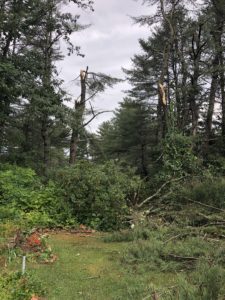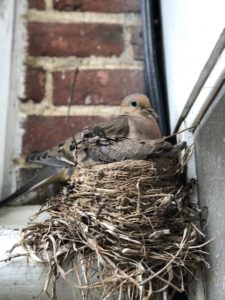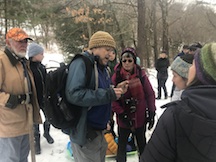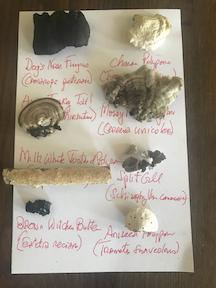By Sandy Stott
“Like great harps on which the wind makes music. There is no finer tree.” — Henry Thoreau writing about the white pine in his Journal, September 16, 1857.
It took one microburst, three consults, and a dark, wind-fraught night before we made the final call.
“Yes, Jeff,” we said to local arborist Jeff Gillis, “we’d like to set up a time to take down our front-yard pine.” Some few minutes later, we had a date.
That October ‘19 night, the power had gone out, unleashing a racket of generators and darkening the street. Rain beat like thrown pebbles on the windows. When I’d stepped outside in the lee of the house, it was utterly dark and alive with the speech of trees enduring. Another thump on the roof punctuated their many-pitched moaning. It was like living inside a drum at a rock concert. 
Throughout the slow hours, we lay awake, counting and huddling toward daylight. Somehow, even the wan light of predawn seemed hopeful. And with it, the wind began to ease; we looked out on a branch-littered world.
When I walked out in the morning, I found that others had been less lucky. Our next door neighbors had had their car crushed, its roof now caved in where driver and passenger once sat. Just down the street, a large pine lay astride a back roof. Inside, an arm-thick branch stub had punched a hole in the ceiling. Water dripped steadily from the limb into a bucket set beneath. Throughout town it was a morning of saws.
When we bought our house nearly 20 years ago, part of its appeal lay in the way it was set within woods. The lot was very small, but wherever you looked through our many windows, you saw trees; their long stalks lifted your eyes. Sky peered through the gaps in the crowns. It was an optimist’s aspect. Many neighbors shared it, living tight to their trees too.
While we all lived day-to-day, the pines grew. High above, they spread the sails of their foliage, caught whatever winds blew and leaned and swayed in response. Their roots, as pine roots will, remained shallow. And, in our neighborhood, which lies atop alluvial sands put down by the last glacier, there’s not much for a tree to grip.
We began to call our front yard pine the Worry-tree; it was our conundrum. Prince of the yard, it rose more than 90 feet due west of our house. On days when I felt so inclined, it was a big hug, too big, in fact, for a little man to grasp. The Worry-tree had its name from its habit of leaning a few degrees east of true. If neighbor Worry were to go anywhere, we would receive it square.
When a microburst blew through in September of 2018, taking down seven large pines within 100 yard radius of the Worry-tree, including a like-sized king pine 50 feet away, we knew we needed to do something. So began the consults.
We considered cabling the two lofty leaders together, but that didn’t answer the pine’s tilt; it simply meant that if it went, we’d get its fullness rather than half a whack. Either one would crush the house. “Go to the basement if a gust-front blows in,” we were told.
After the October ’19 storm, I sent a note to Jeff Gillis:
“Our primary concern with the tree and its threat to our house lies in worry about a gust front/microburst. They often come from the west or northwest as part of a thunderstorm line, and wind from that direction would push the tree right at our house, which is also the way its weight tends. That sort of storm is usually a summer sort, and even a March cut of the tree would get it removed before summer. Winter storms, when they’re severe, tend to be nor’easters, or occasionally blow-ups from the south or southwest, and the wind gusts don’t tend to reach the level of a microburst. So, even as the tree leans in our direction, those winds would tend not to drive it at the house.”
I got this back: “Your reasoning for, and timing of the pine removal sound dead on to me. As such, we will keep the March 12th work date, and, I will continue to look for a sooner time.”
The “sooner time” arrived in January on a 15-degree day that featured also winds up to 25 mph. Not much of a day for time up high, but arborists are hardy folk. We were away, but, throughout the day, I felt a persistent sadness. I’d seen big pines taken down, and I knew roughly how it would go. When we got back, I went out to the stump to take in what was: it measured four feet in diameter, and its rings — counted twice — summed to 85, rife with their thick or thin stories of growth and endure years.
Neighbor tree, I thought, we lived together as long as we could.
Postscript: some solace: after the felling, I talked with the foreman of the crew about his frequent work in our neighborhood.
“Yes,” he said, “when these houses were built, many of the pines were only 40’ high. Now many have reached their limit, and we’re here all the time. In fact, I built half of my house from neighborhood pine. We try to use what we can, so much of our cutting doesn’t end up in a hole.”
A vision of a snug house of local pine rose in my mind; I thought back to the “tall arrowy white pines, still in their youth” that Thoreau felled for his house at Walden. I liked that vision.
Sandy Stott, formerly of Concord, Massachusetts, is a Brunswick, Maine resident, chair of the town’s Conservation Commission, and a member of Brunswick Topsham Land Trust’s Board of Directors. He is the Roost’s founding editor, and he writes for a variety of publications. His recent book, Critical Hours — Search and Rescue in the White Mountains, was published by University Press of New England in April, 2018; Tantor Media released an audio version of the book in February, 2019. He may be reached at fsandystott@gmail.com .



